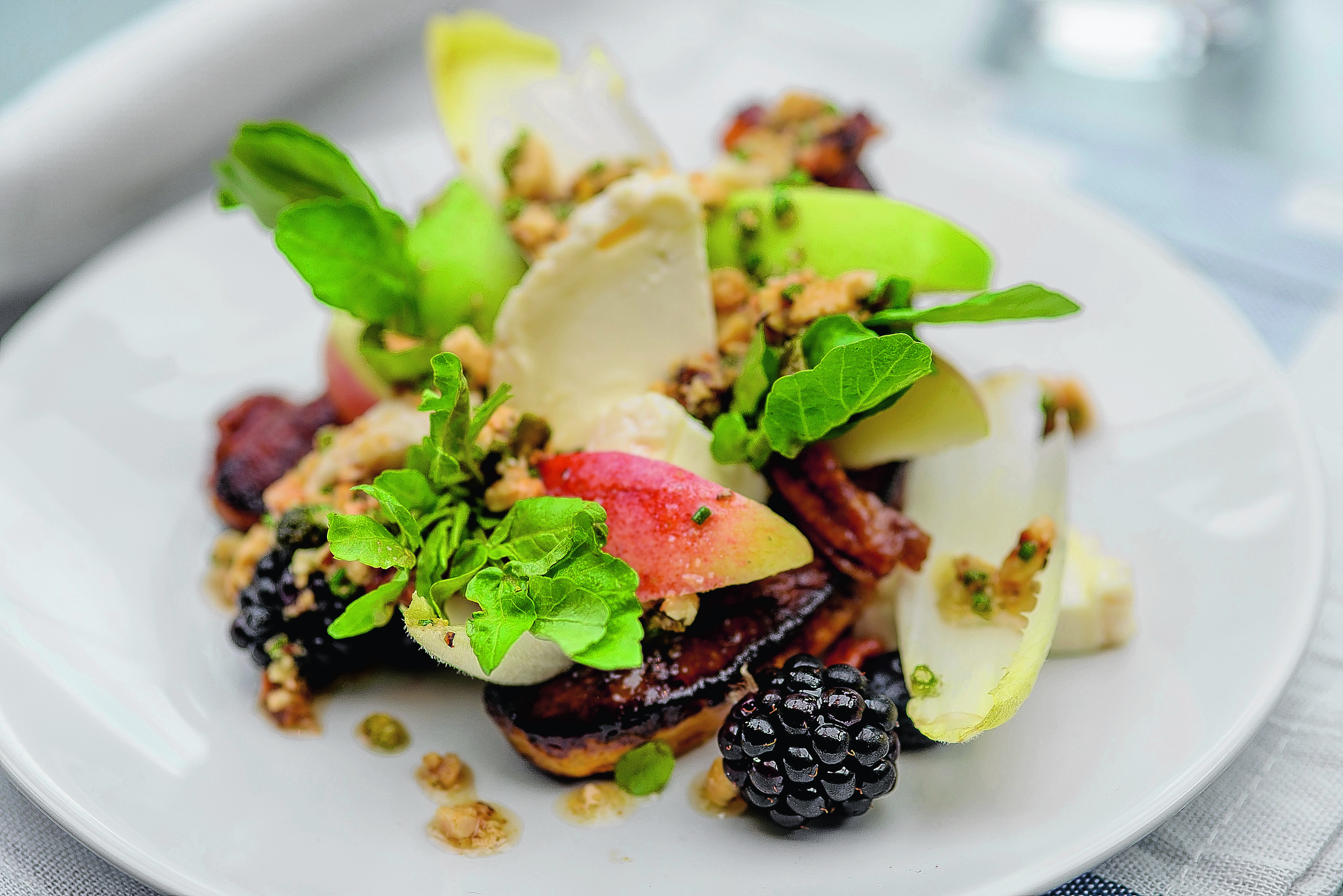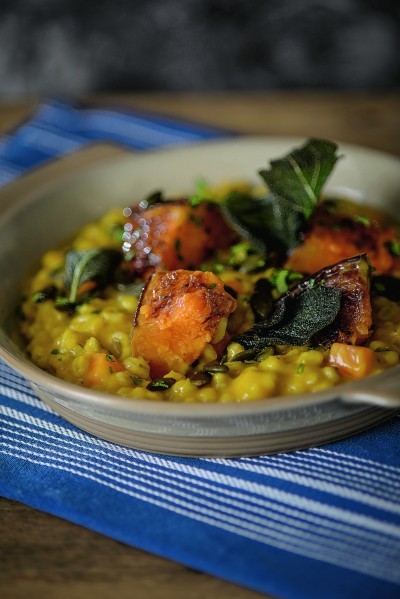Autumn is here and, while we start to feel a little chill in the air, it also brings with it some delicious new seasonal ingredients to my kitchen.
Bold orange vegetables are one welcome addition and varieties of pumpkin and squash are a perfect way to brighten up the plate at this time of year.
Pumpkin tends to be associated with Halloween but it’s a really wonderful ingredient to enjoy in a whole host of dishes.
You’ll also find a huge variety of squash at this time of year, in all different shapes, sizes and colours.
Butternut squash is the most common and popular type of squash and its flesh has a lovely buttery flavour that means, like pumpkin, it can even be used in puddings or desserts.
The beauty of most pumpkin and squash is that you can use every single part, from the outer rind to the delicious flesh to the seeds you’ll find hidden inside.
Roasted pumpkin seeds or butternut squash seeds are great on their own or indeed in biscuits, snacks or salads.
Nothing should go to waste as it all offers a deliciously gentle sweetness and nutty, earthy flavour.
Try using pumpkin or squash in lots of different dishes from autumnal salads or soups, to risottos and stews, and even as a glorious match to the season’s grouse and game.
I’ve included some of my favourite recipes that use pumpkin this week but they can all be easily adapted to butternut squash and indeed any other type of squash you may have picked up from your local farmers’ market or grocer.
SCOTTISH GROUSE WITH ROASTED PUMPKIN, JERUSALEM ARTICHOKES AND BEETROOT WITH HAZLENUT DRESSING
SERVES 2
2 grouse, prepared and wrapped in bacon
1 tbsp vegetable oil
50g/2oz each of celeriac, carrots and celery all chopped into cm/1/2″ dice
10 baby onions
2 sprigs fresh thyme
1 tbsp brandy
250ml/9fl oz chicken stock
Sea salt and freshly ground black pepper
For the roasted vegetables:
2 beetroot, peeled and quartered
Sea salt and freshly ground black pepper
4 Jerusalem artichokes
Lemon, juice only
1kg/2lb 2oz pumpkin, peeled, seeds removed
Olive oil, for frying
50g/2oz hazelnuts, roughly chopped
2 shallots, finely chopped
1 tbsp chopped chives
50ml/2fl oz hazelnut oil
1 tsp sherry vinegar, or to taste
Handful watercress sprigs
For the grouse:
Take the grouse out of the fridge so that they can come to room temperature before you start cooking, and preheat the oven to 200C/400F/Gas 6.
Heat the vegetable oil in a large heavy-bottomed roasting tin. Season the grouse well, inside and out, then sear them in the tin until golden brown all over.
Add the diced vegetables, baby onions and thyme sprigs to the tin.
Place the grouse on one breast and roast in the hot oven for 3-4 minutes. Flip the birds on to the other breast and roast for another 3 minutes.
Pour brandy into the cavity of both birds and place them on their back to finish roasting – another 5 minutes. Remove the tin from the oven and leave the grouse to rest for 10 minutes, out of the tin, breast upwards so the juices are evenly distributed.
Remove the vegetables with a slotted spoon for later use, and set aside all the pan juices.
Put the roasting tin back on the heat on top of the stove and begin to reduce the cooking juices. Add the chicken stock, bring to the boil and let the sauce reduce and thicken. Take off the heat and pass through a fine sieve – keep warm until ready to serve.
For the roasted vegetables:
Heat the oven to 180C/350F/Gas 4.
Place the beetroot quarters into a saucepan and pour in enough water to cover. Add salt and bring to the boil. Simmer for 30 minutes or until the beetroot is nearly cooked. Drain and set aside.
Meanwhile, peel the Jerusalem artichokes, cut them in half and immerse in a bowl of cold water with the lemon juice added to stop them discolouring.
Cut the pumpkin into thick slices.
Heat a large non-stick ovenproof frying pan (or a cast-iron roasting pan) over a medium-high heat and add a drizzle of olive oil.
Place the pumpkin and Jerusalem artichokes into the pan, season with salt and cook for 3-4 minutes, until they start to colour.
Transfer the whole pan to the oven and roast for 15 minutes.
Cut the par-cooked beetroot into wedges, add to the pan and cook in the oven for a further five minutes.
Meanwhile, make the dressing. Combine the chopped hazelnuts, shallots, chives and hazelnut oil in a bowl. Add a splash of sherry vinegar and season with salt and pepper to taste.
To serve:
Once the grouse have rested, carve the legs and breast meat onto a plate and spoon over the pan juices. Serve the roasted vegetables alongside with the dressing and watercress on top.
PUMPKIN AND PEARL BARLEY RISOTTO
SERVES 4
250g Pearl barley
1ltr vegetable stock
4 shallots (diced finely)
1 medium pumpkin
100g of butter
1 tbs chives (chopped finely)
Extra virgin olive oil
Sage leaves (deep-fried until crispy)
Prep the pumpkin into chunky wedges. You can also retain and dry, then roast the pumpkin seeds.
Roast the pumpkin wedges in the oven until golden and well caramelised. Retain some nice pieces to garnish, purée the remaining roasted pumpkin in a blender until smooth. Reserve until later.
Put vegetable stock in a pan to heat. Sweat the diced shallot in a little olive oil until completely soft. Then add the pearl barley and 50g of butter and lightly “roast” the grains in the butter, without adding any colour.
When the grains appear translucent on the outside begin adding the heated stock, one ladle at a time, whilst stirring very gently but continuously to avoid the grains sticking to the pan.
Continue ladling stock and cooking until the grains are almost cooked through. Then stir in a 50g of butter and some of the pumpkin purée to create a nice orange colour.
When at the right consistency, remove from the heat and serve with roasted pumpkin seeds, the retained pumpkin pieces, chopped chives, crispy sage leaves and a drizzle of olive oil.
ROASTED PUMPKIN, WINTER VEGETABLES AND FRUITS, SERVED WITH GOAT’S CHEESE AND HAZELNUTS
SERVES 4
500g pumpkin – cut into moons
1 apple – cut into quarters
1 endive – leaves separated
200g good quality goat’s cheese
Handful of watercress
2 handfuls of late season brambles or berries
Olive oil for cooking
For the hazelnut dressing:
1 tbsp each of chopped hazelnuts, walnuts and pistachios
1 tsp each of peeled and finely chopped shallots, finely chopped chives, finely chopped parsley
50ml hazelnut oil
Dash of sherry vinegar
Pre heat the oven to 180°C /Gas 4.
Peel away the skin (or you can keep the skin on if you prefer) from the pumpkin and remove the seeds. Cut into thick moon-shaped slices.
Heat a non-stick frying pan and heat some olive oil. Add the pumpkin and season with salt. Cook for 3-4 minutes until it colours nicely – it should take on a lovely golden colour.
Turn and colour the other side, then place in the oven for 6-8 minutes. To check the pumpkin is cooked, insert a small knife into the pumpkin to check the resistance. If there is some resistance, it needs a little longer.
Once cooked, remove the pumpkin from the pan and set aside.
Meanwhile, to make the dressing, place all the chopped nuts in a bowl. Combine with the shallots, chives and a touch of seasoning.
Drizzle in the hazelnut oil and add a splash of sherry vinegar. Finally, add the chopped parsley and set aside.
To prepare the salad, cut the apple into quarters, separate the endive leaves, and chop the goat’s cheese, and build them up on your plate as a layered tower.
Add the watercress, and then the autumn berries to the plate. Just before serving, drizzle with the hazelnut dressing.

